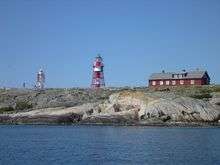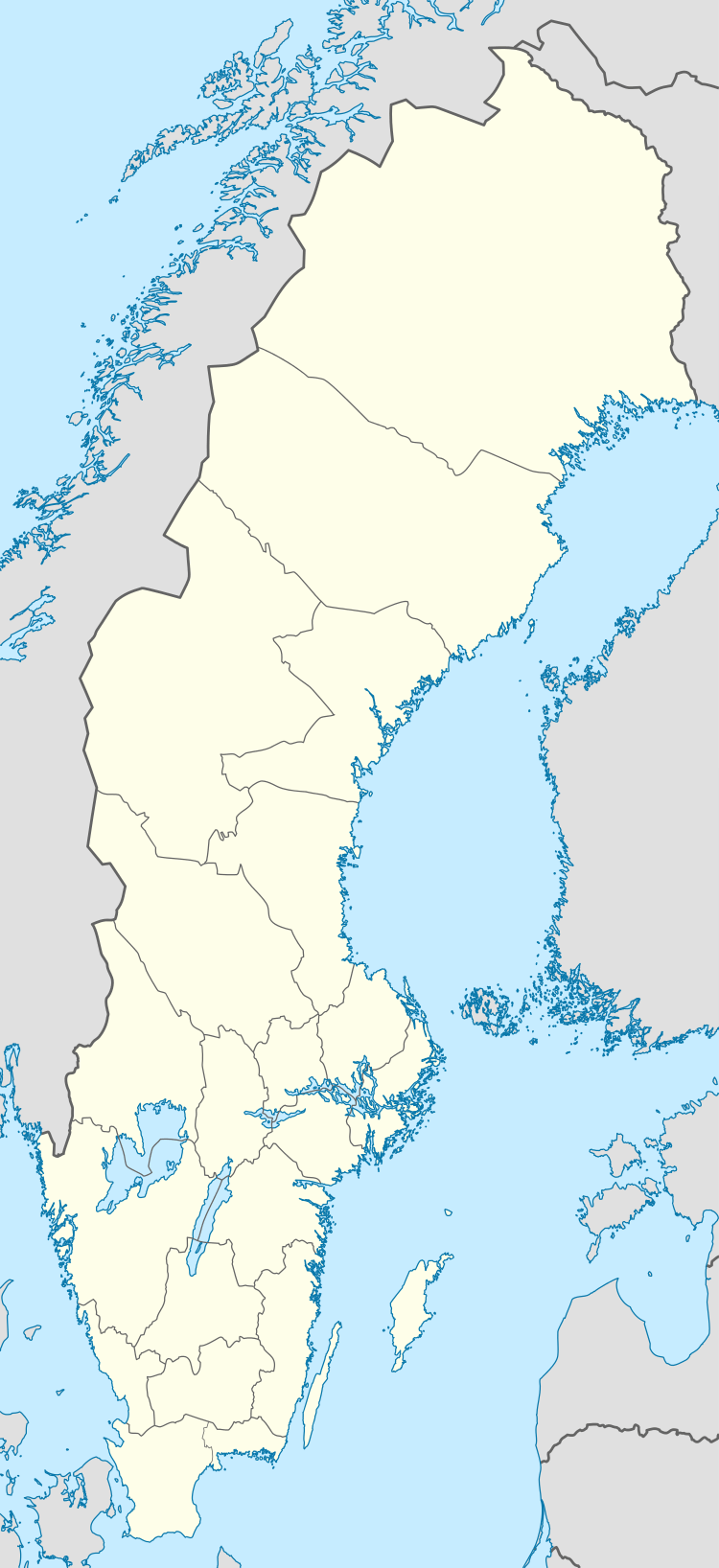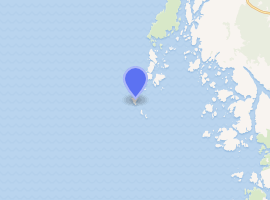Måseskär
Måseskär (en: The Gull Skerry) is a rocky island and a lighthouse station located in the sea of Skagerrak on the west coast of Sweden.
 Måseskär new and old lighthouse. | |
 Sweden | |

| |
| Location | Måseskär west of Käringön Skagerrak sea Sweden |
|---|---|
| Coordinates | 58.094124°N 11.330617°E |
| Year first constructed | 1865 (first) |
| Year first lit | 1978 (current) |
| Automated | 1978 |
| Deactivated | 1978 (first) |
| Construction | concrete tower (current) cast iron skeletal tower (first) |
| Tower shape | cylindrical tower with balcony, lantern and four daymark panels (current) pyramidal skeletal tower with balcony, lantern and central cylinder (first) |
| Markings / pattern | white tower and lantern, red daymark panels (current) white and red tower as checkerboard sample (first) |
| Tower height | 13 metres (43 ft) (current) 27 metres (89 ft) (first) |
| Focal height | 275 metres (902 ft) (current) |
| Original lens | 2nd order Fresnel lens |
| Current lens | 4th order modern lens |
| Range | white: 16 nautical miles (30 km; 18 mi) red: 13 nautical miles (24 km; 15 mi) green: 12 nautical miles (22 km; 14 mi) |
| Characteristic | Fl (3) WRG 30s. |
| Admiralty number | C0448 |
| NGA number | 0584 |
| ARLHS number | SWE-276 (current) SWE-047 (first) |
| Sweden number | SV-8206 |
| Managing agent | Swedish Maritime Administration (Sjöfartsverket)[1] [2] |
History
Since the year 1829, a daymark had been constructed on the island, but it proved not to be enough since many ships were lost in the area. It was demolished during the lighthouse construction. The tower was built after sketches from Swedish lighthouse pioneer Nils Gustaf von Heidenstam. Originally the flame ran on colza oil-lamps and showed red light. In 1884 a kerosene lamp was installed instead, and in 1887 the large lens was changed to a third order fresnel lens with white light. The old lens was divided and placed in two other lighthouses. Electricity came to the island in 1950, but the station was staffed until 1997. It was then one of the last staffed light stations in Sweden along with Söderarm and Holmögadd. In 1978 the old lighthouse was replaced, deactivated and planned for scrapping due to its bad rusty condition. But a rescue group convinced the Swedish Maritime Administration to donate the scrap funding and the lighthouse to them for repairs and historic preservation. They created the Måseskär foundation and works to preserve all light station buildings on the island. The modern lighthouse is still under control of the Swedish Maritime Administration. The old lighthouse is intact and fully operable. Since the year 2000 there is a tradition among the foundation to turn on the light at 00.00 January 1 for a couple of minutes. The island is included as a wind observation station in the shipping news of the Swedish Meteorological and Hydrological Institute.
Climate
The weather station operated at Måseskär indicates an oceanic climate that is heavily moderated by Swedish standards. Many typical features of an oceanic climate is there, such as seasonal lag, low diurnal temperature variation rendering cool days and warm nights, and a lower than normal seasonal temperature variation. Although Måseskär has never recorded a temperature above 29.6 °C (85.3 °F) it is a hotspot for tropical nights (minima above 20 °C (68 °F) due to said maritime influence that keeps the sea warm during summer nights. Remarkably high autumn daily means are also common due to the lag effect. For example, the daily means of September and October are on average warmer than the highs of May and April respectively. Summer nights are also some of the warmest in Sweden. During the coldest month (February) frosts are regular, but rarely severe. Months with daytime averaging below freezing are rare but not impossible, only occurring when inland temperatures are very cold.
Rainfall is comparatively low for a Kattegat station, totalling 579.6 millimetres (22.82 in) per year between 1961 and 1990.[3]
| Climate data for Måseskär (2002–2018; extremes since 1901) | |||||||||||||
|---|---|---|---|---|---|---|---|---|---|---|---|---|---|
| Month | Jan | Feb | Mar | Apr | May | Jun | Jul | Aug | Sep | Oct | Nov | Dec | Year |
| Record high °C (°F) | 10.2 (50.4) |
9.9 (49.8) |
14.2 (57.6) |
24.3 (75.7) |
27.7 (81.9) |
29.6 (85.3) |
29.5 (85.1) |
29.6 (85.3) |
26.6 (79.9) |
18.0 (64.4) |
13.7 (56.7) |
11.6 (52.9) |
29.6 (85.3) |
| Mean maximum °C (°F) | 7.1 (44.8) |
6.0 (42.8) |
8.9 (48.0) |
14.1 (57.4) |
20.6 (69.1) |
22.6 (72.7) |
24.7 (76.5) |
23.9 (75.0) |
20.2 (68.4) |
15.1 (59.2) |
11.5 (52.7) |
8.6 (47.5) |
25.8 (78.4) |
| Average high °C (°F) | 2.8 (37.0) |
2.0 (35.6) |
4.3 (39.7) |
8.9 (48.0) |
14.1 (57.4) |
17.2 (63.0) |
19.9 (67.8) |
19.6 (67.3) |
16.4 (61.5) |
11.5 (52.7) |
7.8 (46.0) |
5.0 (41.0) |
10.8 (51.4) |
| Daily mean °C (°F) | 1.2 (34.2) |
0.5 (32.9) |
2.6 (36.7) |
6.9 (44.4) |
11.9 (53.4) |
15.2 (59.4) |
18.0 (64.4) |
17.7 (63.9) |
14.7 (58.5) |
9.9 (49.8) |
6.3 (43.3) |
3.4 (38.1) |
9.0 (48.3) |
| Average low °C (°F) | −0.5 (31.1) |
−1.0 (30.2) |
0.8 (33.4) |
4.8 (40.6) |
9.6 (49.3) |
13.2 (55.8) |
16.0 (60.8) |
15.8 (60.4) |
13.0 (55.4) |
8.3 (46.9) |
4.7 (40.5) |
1.7 (35.1) |
7.2 (45.0) |
| Mean minimum °C (°F) | −7.2 (19.0) |
−6.7 (19.9) |
−4.1 (24.6) |
0.6 (33.1) |
5.0 (41.0) |
9.4 (48.9) |
13.2 (55.8) |
12.2 (54.0) |
8.7 (47.7) |
3.0 (37.4) |
−1.6 (29.1) |
−4.3 (24.3) |
−9.6 (14.7) |
| Record low °C (°F) | −25.0 (−13.0) |
−19.3 (−2.7) |
−18.1 (−0.6) |
−8.8 (16.2) |
−0.8 (30.6) |
5.4 (41.7) |
9.0 (48.2) |
6.6 (43.9) |
3.5 (38.3) |
−3.2 (26.2) |
−9.3 (15.3) |
−19.0 (−2.2) |
−25.0 (−13.0) |
| Average precipitation mm (inches) | 41.9 (1.65) |
26.7 (1.05) |
25.5 (1.00) |
36.7 (1.44) |
41.0 (1.61) |
55.6 (2.19) |
61.3 (2.41) |
72.3 (2.85) |
53.8 (2.12) |
66.2 (2.61) |
57.2 (2.25) |
46.6 (1.83) |
584.8 (23.01) |
| Source 1: SMHI[4] | |||||||||||||
| Source 2: SMHI Monthly Data 2002–2018[5] | |||||||||||||
References
- Måseskär The Lighthouse Directory. University of North Carolina at Chapel Hill. Retrieved April 5, 2016
- Leuchtturm Måseskär www.schwedische-leuchtfeuer.de
- "Precipitation normals 1961-1990 (Måseskär code 8106)" (in Swedish). SMHI. Archived from the original on 28 September 2018. Retrieved 25 June 2016.
- "Öppna Data för Måseskär" (in Swedish). Swedish Meteorological and Hydrological Institute.
- "Monthly and Yearly Statistics" (in Swedish). SMHI. 17 May 2019.
- Rowlett, Russ. "Lighthouses of Sweden: Uddevalla Area (Central Bohuslän)". The Lighthouse Directory. University of North Carolina at Chapel Hill. Retrieved 28 August 2010.
External links
- Sjofartsverket (in English)
- The Swedish Lighthouse Society
| Wikimedia Commons has media related to Måseskär. |